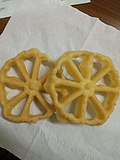This article needs additional citations for verification .(January 2010) |

This is a list of selected dishes found in Indonesian cuisine .
Contents
- Staple foods
- Main dishes
- Curries
- Meals
- Soy-based foods
- Preserved meats
- Rice dishes and porridges
- Congees and porridges
- Rice cake dishes
- Rice dishes
- Noodle dishes
- Soups and stews
- Salads and vegetable dishes
- Breads and sandwiches
- Snacks and starters
- Savoury snacks
- Sweet snacks
- Crackers, chips, and crisps
- Sweet desserts
- Cheeses
- Beverages
- Seasonings and condiments
- Common ingredients
- Spices
- Herbs
- Vegetables
- Fruits
- Gallery
- See also
- References
- External links

































































































































































































































































































































































































































































